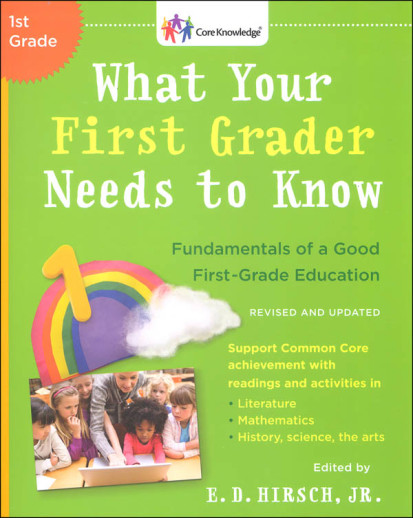We use cookies to make your experience better. To comply with the new e-Privacy directive, we need to ask for your consent to set the cookies. Learn more.
What Your 1st Grader Needs to Know
The 1st Grade edition is divided into the sections of Language and Literature, History and Geography, Visual Arts, Music, Mathematics, and Science. ‘Language and Literature’ covers the basics of reading and reading aloud poems and rhymes, Aesop’s Fables, stories, tales, and familiar sayings with meaning. In the margins of the stories, new words are listed along with questions to ask your child about the story content. ‘History and Geography’ covers Ice Age, Egypt, Pharaohs, hieroglyphics, Nile River, Mesopotamia, Religions (Judaism, Christianity, and Islam). Geography covers the land bridge, Maya, Aztec City, Inca Empire, Europeans, Spanish Conquerors, Mexico, England, The Lost Colony, Jamestown, Pilgrims, Slavery, 13 colonies, to a nation being born. ‘Visual Arts’ centers on drawing, painting, cutting and getting to know some works of art. Identifying shapes, textures, portraits, and murals. ‘Music’ introduces Mozart, instruments, operas, dance, and familiar songs. ‘Mathematics’ reviews numbers, counting to 100, fractions, addition and subtraction 1-12, money, geometry, measurement, and time. In ‘Science’ living things and their habitats will be covered along with the human body, measurements, electricity, astronomy, and the earth. 473 pgs, pb. ~Amber
Give your child a smart start with the revised and updatedWhat Your First Grader Needs to Know
What will your child be expected to learn in the first grade? How can you help him or her at home? How can teachers foster active, successful learning in the classroom? This book answers these all-important questions and more, offering the specific shared knowledge that hundreds of parents and teachers across the nation have agreed upon for American first graders. Featuring a new Introduction, filled with opportunities for reading aloud and fostering discussion, this first-grade volume of the acclaimed Core Knowledge Series presents the sort of knowledge and skills that should be at the core of a challenging first-grade education. Inside you’ll discover
• Favorite poems—old and new, such as “The Owl and the Pussycat,” “Wynken, Blynken, and Nod,” and “Thirty Days Hath September”
• Beloved stories—from many times and lands, including a selection of Aesop’s fables, “Hansel and Gretel,” “All Stories Are Anansi’s,” “The Tale of Peter Rabbit,” and more
• Familiar sayings and phrases—such as “Do unto others as you would have them do unto you” and “Practice makes perfect”
• World and American history and geography—take a trip down the Nile with King Tut and learn about the early days of our country, including the story of Jamestown, the Pilgrims, and the American Revolution
• Visual arts—fun activities plus full-color reproductions of masterworks by Leonardo da Vinci, Vincent van Gogh, Paul Cézanne, Georgia O’Keeffe, and others
• Music—engaging introductions to great composers and music, including classical music, opera, and jazz, as well as a selection of favorite children’s songs
• Math—a variety of activities to help your child learn to count, add and subtract, solve problems, recognize geometrical shapes and patterns, and learn about telling time
• Science—interesting discussions of living things and their habitats, the human body, the states of matter, electricity, our solar system, and what’s inside the earth, plus stories of famous scientists such as Thomas Edison and Louis Pasteur
Please note that the K-8 Core Knowledge Sequence is now available as a free download at www.coreknowledge.org.
Designed for use as a supplement to a basal curriculum, E. D. Hirsch's series adds historical and literary study (such as would be found in a classical curriculum) to the typical school curriculum. These guides cover things such as Language Arts, World history and geography, American history and geography, Visual Arts, Mathematics, Life and Physical Sciences. The selections are interesting and the format makes these books easy to use. There are also sections for the parent introducing each subject area and providing helpful information on using the selections. Many of the topics could form the basis for interesting unit studies. While you will need to use something more for a complete curriculum (additional math lessons or program, spelling, handwriting), these books should go a long way in extending your teaching to include a more "classical" component. Or consider using them as originally intended - spending the suggested 15 minutes per day going through them with your children as an interesting cultural extension for school. Paperback.
C33
Please note that the K-8 Core Knowledge Sequence is now available as a free download at www.coreknowledge.org.
| Product Format: | Softcover Book |
|---|---|
| Brand: | Bantam, Doubleday and Dell |
| Author: | E.D. Hirsch |
| Grade: | 1 |
| ISBN: | 9780553392388 |
| Length in Inches: | 9.125 |
| Width in Inches: | 7.5 |
| Height in Inches: | 1.125 |
| Weight in Pounds: | 3.05 |

